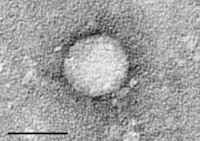
Photo from wikipedia
DNA damage has been considered the primary action of ionizing radiation (IR) in normal and tumor cells resulting in cell autonomous death. However, recent findings have elucidated novel local and… Click to show full abstract
DNA damage has been considered the primary action of ionizing radiation (IR) in normal and tumor cells resulting in cell autonomous death. However, recent findings have elucidated novel local and systemic effects of IR mediated by the induction of Type I interferons (IFN) and activation of adaptive immune responses. These responses are initiated by DNA- and RNA-dependent activation of pattern recognition receptors (PRR) which comprise an innate immunity system responsible for detection of exogenous pathogens, mounting of an anti-viral response, and activation of adaptive immunity. Activation of cytoplasmic RNA sensors by endogenous dsRNAs has emerged as an important mechanism of tumor cell-intrinsic Type I IFN induction in the response to genotoxic therapies. The fact that an effective anti-tumor effect of IR and chemotherapy response is dependent on the RNA sensing pathways indicates that tumor cells are equipped by functional innate immunity system which recognizes genotoxic stress insult as an intrusion of exogenous RNA pathogens. This indicates that DNA damage leads to the RNA stress, which is recognized as danger-associated molecular patterns (DAMPs) presented by aberrant RNA molecules interacting with cytoplasmic RNA sensors. In the current review, we will discuss the mechanistic bases for RNA-dependent innate responses in tumor cells, RNA ligands recognized as DAMPs, and the potential implications of these findings to improve cancer therapies.
Journal Title: International review of cell and molecular biology
Year Published: 2019
Link to full text (if available)
Share on Social Media: Sign Up to like & get
recommendations!